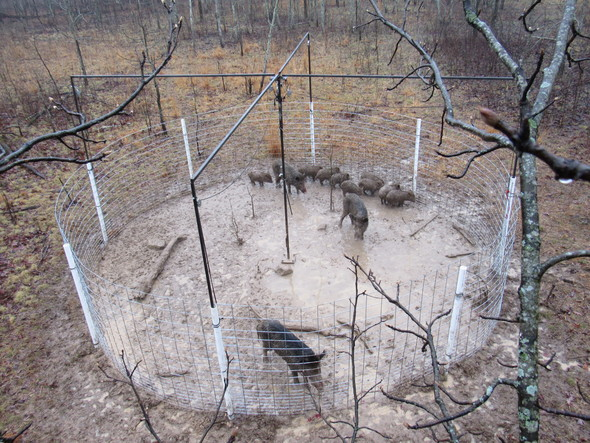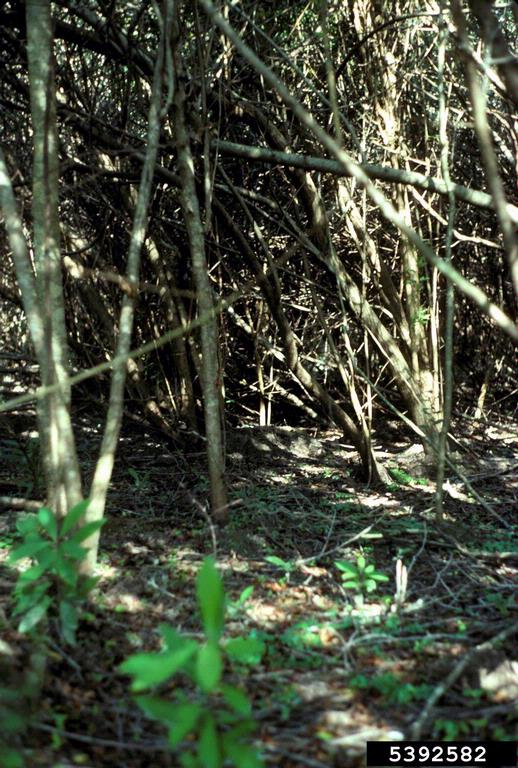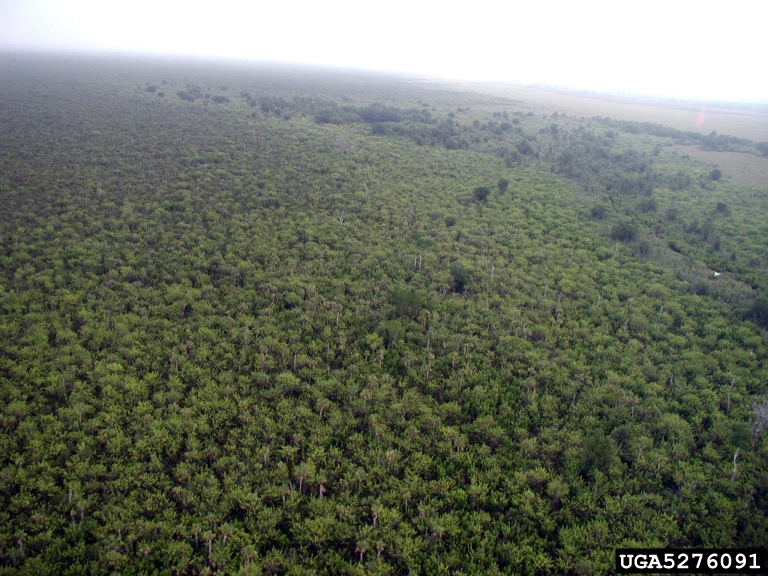Missouri Makes Progress in Eradicating Feral Hogs – Despite Sabotage
Feral hogs have expanded their range in the U.S. from 17 to 38 states over the past 30 years. Their populations grow rapidly because feral hogs can breed any time of the year and produce two litters of one to seven piglets every 12 to 15 months. [See MDC Press Release, January 25, 2019]

Missouri Department of Conservation
Missouri’s program is increasingly successful: the numbers of hogs removed has risen from 5,358 in 2016, to 6,561 in 2017, to 9.365 in 2018. [See MDC Press Release, January 25, 2019] I have previously praised Missouri’s scientifically-based program to eradicate feral hogs – here and here (Missouri has extensive material on feral hogs posted here)
According to the Missouri Department of Conservation’s feral hog elimination team leader, Mark McLain, said “This strategic approach is important because if we leave even a few feral hogs behind in an area, they can reproduce quickly and put us back where we started.”
According to McLain, hunting is not an effective method for eliminating feral hog populations. “For over 20 years, unregulated hunting of feral hogs was allowed in Missouri, during which time our feral hog population expanded from a few counties to over 30 counties,” he said.
In 2017, MDC, the Corps of Engineers, and the LAD Foundation established regulations against feral hog hunting on lands owned and managed by these three organizations. Other agencies have passed regulations similar to MDC’s to eliminate hog hunting on land they own.
However, illegal releases of feral hogs continue. The February 2019 press release (referenced below) describes several examples of the problems such releases cause. McLain said that those who release feral hogs face hefty fines. Hunting, especially with dogs, pushes the hogs onto neighboring property, which causes problems for neighbors. The hogs travel back and forth between the properties, escaping and causing more damage. Trapping with no hunting interference is the best method to eliminate them.
MDC advises landowners to seek help from the Department and USDA APHIS. These agencies providetechnical advice and training; conduct on-site visits; and loan equipment.
Are feral hog programs in other states using the same methods? Are they as successful?
SOURCES
Missouri Department of Conservation. More than 9,300 Feral Hogs Eliminated from Missouri in 2018. Press Release. January 25, 2019.
Missouri Department of Conservation. Interference with feral hog trapping sites costs trappers time, taxpayers money. Press Release. February 21, 2019.
Florida Looks to Biocontrol to Makes Progress Against Some of its Worst Invasive Plants

John Randall, The Nature Conservancy
www.bugwood.org
Until recently, melaleuca (Melaleuca quinquenervia) was considered the worst invasive tree or shrub in Florida. It threatened to convert the everglades “sea of grass” into a thicket of exotic trees which could not support native wildlife. Thanks to the biocontrol agent Oxyops vitiosa, melaleuca is considered to be under maintenance control on public conservation land in the state. Still, melaleuca control demands about $2 million per year because of the huge area previously (and still) affected by the tree.
Now Florida is about to release biocontrol agents to attack Brazilian pepper (Schinus terebinthifolius). In Florida, Brazilian peppertree is found from Monroe County in the south to St. Johns, Levy, and Nassau counties in the north plus Franklin County in the Panhandle. An estimated 283,000 hectares of south and central Florida are invaded. The South Florida Water Management District alone is spending approximately $1.7 million per year (as of 2011) to control it.
Brazilian peppertree invades disturbed sites such as canal banks and fallow farmlands. Of greater concern to me are the many natural communities invaded – Brazilian peppertree infests more natural areas in Florida than any other invasive plant species. Invaded ecosystems include pinelands, hardwood hammocks, and critically important mangrove forests. The coastal mangroves are valued because of their high productivity, wildlife habitat, and shoreline protection and stabilization.

Tony Pernas, USDI National Park Service
www.bugwood.org
Dense stands of Brazilian peppertree shade out and may kill food plants used by white-tailed deer – key prey for the endangered Florida panther. Other mammals and birds might be poisoned by toxic resins in the bark, leaves and fruits — although some birds feed extensively on the fruits – and thereby contribute to spread of the invasive plant.
Existing options for management of Brazilian peppertree, including chemical, mechanical, and physical control measures, have been used with some success against this weed. However, applying these strategies repeatedly to prevent regrowth is costly and labor intensive. Furthermore, such practices can be detrimental to native vegetation. For example, mangroves are particularly sensitive to both herbicides and the soil disturbances associated with mechanical control
After more than 20 years of searching, Florida hopes it has identified useful biocontrol agents. USDA APHIS is seeking public comment on the proposed release of two insect species, Calophya latiforceps (a leaf galling psyllid) and Pseudophilothrips ichini (a thrips) as biological control agents targetting Brazilian pepper.
Much as I sympathize – Brazilian peppertree is a highly damaging invasive plant and there are no other effective control measures – I have questions. First, the psyllid is sedentary; dispersal would be by wind. Would this limit its efficacy?
More troubling is host specificity. The Environmental Assessment (available here) reveals that the thrips can reproduce in low numbers on several non-target plant species, including the Hawaiian sumac Rhus sandwicensis. True, the proposal is to release the biocontrol agents on the continent, not on Hawai`i. But insects have often been transported inadvertently to Hawai`i – and the islands’ plant species have often proved highly vulnerable to attack by non-native species (I confess that the most recent examples are pathogens, e.g., ‘ōhi‘a rust and rapid ‘ōhi‘a death.)
APHIS is accepting comments on the Environmental Assessment until March 29. Please consider providing your views. Again, the document is available here.
RESULTS
In June 2019, APHIS announced that it would issue permits for release of the two biocontrol agents on the continent – starting in Florida – without any restrictions. APHIS dismissed my concerns about the potential threat to native Hawaiian plants — Rhus sandwicensis and Dodonaea viscosa. See the agency’s responses in Appendix 7.
As regards the potential threat to the two Hawaiian species from the thrips Pseudophilothrips ichini APHIS chose to ignore my two greatest concerns:
1) that insects are introduced accidentally to Hawai`i frequently – so the threat from this thrips must be considered.
2) if introduced to Hawai`i, P. ichini would have ample resources to maintain high population levels and so could put constant pressure on Rhus sandwicensis and Dodonaea viscosa even ‘though neither plant itself supports more than one generation of the thrips.
In response to my query as to who in Texas would be consulted re: possible release of the biocontrol agents in that state, APHIS replied the chief state plant regulatory official (head of plant pest issues in the state Department of Agriculture) and the APHIS representative in the state. No conservation authorities are designated. Nor would APHIS prepare a new environmental assessment – although the current one cites data almost exclusively for Florida.
One good response: in response to my concerns that the psyllid Calophya latiforceps is too sedentary to spread through the hundreds of thousands of acres invaded by Brazilian pepper, APHIS clarifies that a mass rearing and release program is under development.
Posted by Faith Campbell
We welcome comments that supplement or correct factual information, suggest new approaches, or promote thoughtful consideration. We post comments that disagree with us — but not those we judge to be not civil or inflammatory.